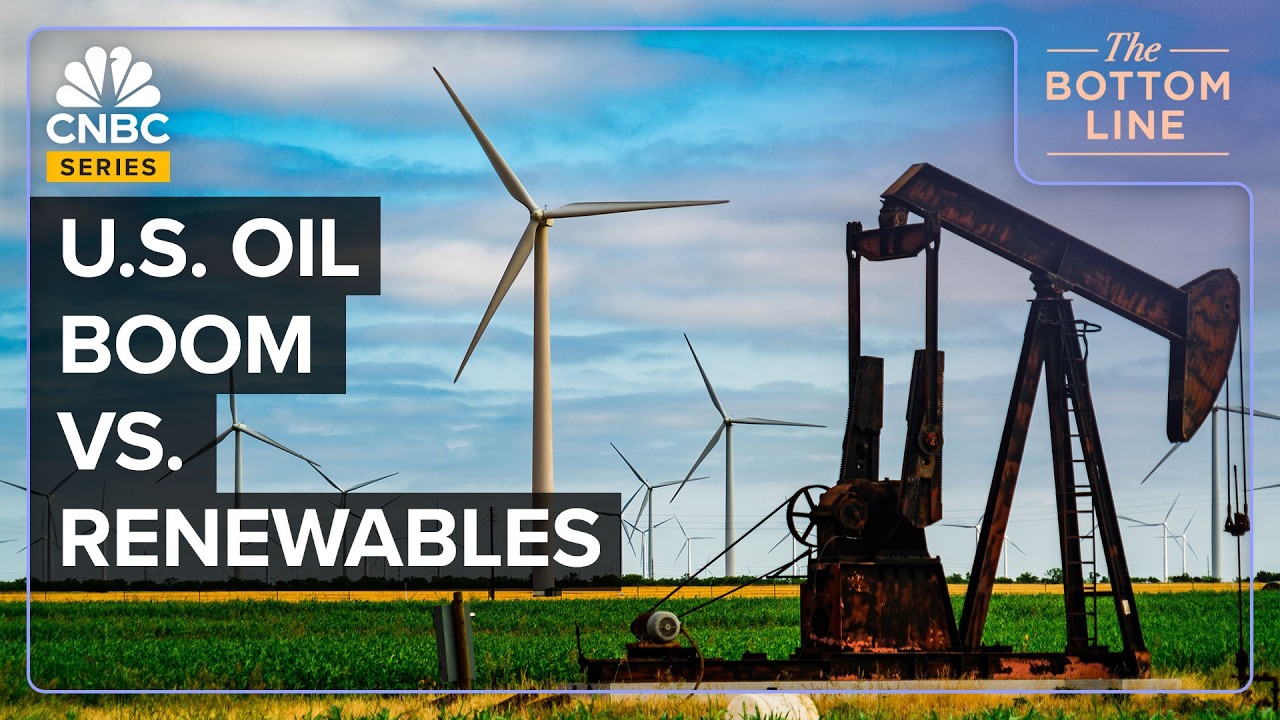The U.S. is producing more oil than ever. In fact, the U.S. Is pumping more oil than any country ever has in the
history of the world. It's very profitable right now to drill in the United
States. U.S. oil production hit 13.4 million barrels a day. People were saying we'd never get past 12 million
barrels a day. So, it's a big number. Big oil companies like ExxonMobil, Chevron, shell,
TotalEnergies and BP have raked in Nearly $173 billion of profits in 2023, according to
the National Resources Defense Council. At the same time, billions of dollars worth of tax
breaks incentivize domestic oil production. In the end, we need energy to do our daily lives, but
we also have to cope with climate change. Renewable energy companies like NextEra energy, First
Solar, GE Vernova and Constellation Energy Have seen stock prices stumble ahead of the 2024
election as tax credits hang in the balance. That's because the renewable energy transition has
received billions of dollars worth of government Support, and it may be costing more than expected. The transition that we're talking about, it's not
starting today. It didn't even start yesterday. It started years and
years ago. And they actually happened during the Biden
administration. They happened during the Trump administration as well. We're building out the infrastructure for clean energy. But, we can't retire the infrastructure for oil
because we're still using it. So, how did the U.S. Become the largest oil producer of all time? And what does that mean for the transition to greener
energy sources? Oil is critical to the US economy. If you think about how we move around. If you think about how we live. A lot of that is based in ample and easily accessible
natural resources. For the last more than 100 years, most of that energy
has come from fossil sources. The price of oil impacts almost every American
household. When oil prices are high, gasoline and energy bills
are more expensive, which can lead to increased Inflation. When oil prices are low, the cost of doing
business is cheaper, which can boost economic growth. So, oil prices have gotten a lot of lift in recent
years because of the war in Ukraine and then you had
The tensions in the Middle East, which also kept oil
prices high. And, that signaled to the American companies that they
could drill again and there would be a market for their Oil. The research and development of hydraulic fracturing
and horizontal drilling techniques have majorly Contributed to the boom in U.S. Crude oil and natural gas production. In the 90s and into the 2000s, you know, everybody was
thinking we were running out of oil and all this stuff. And, of course, the United States industry came up
with these incredible technology breakthroughs to Basically be able to squeeze oil out of what looks to
the naked eye to be a completely solid rock. This is also known as fracking. Fracking has all of a sudden made natural gas much,
much more affordable. Just to give you a comparison, oil production was at 5
million barrels a day before we had the Breakthroughs with horizontal drilling and fracking. And, now we're at about 13.5 million barrels a day. These three charts show how the U.S. Oil industry has become more productive than ever,
largely due to fracking. The advancement has allowed oil wells, both new and
existing, to have more oil extracted than they Otherwise would have. The number of new oil wells fluctuated over the past
decade, but since 2020 and the Covid-19 Pandemic, the amount of new oil wells coming online
has gradually increased at a slower rate when compared To pre-pandemic years. At the same time, active oil directed rigs, which
indicate how many new oil wells can be drilled, has Trended downwards. So, despite the 69% decrease in the amount of active
rigs since 2014, U.S. Crude oil production has seen a recent boom because of
advancements in efficiency. The United States is not only the largest oil producer
in the world, but we're also among one of the largest Oil exporters. The US is exporting more oil than ever. We are a major, major player in the international oil
market, and that's really changed the nature of the Market because if the United States industry was not
participating with that success, oil prices would be A lot higher and a lot more volatile. The U.S. exported more oil to European allies that are
shifting away from dependency on Russian Oil. There's been a lot of attention on where natural gas
comes from, especially in the wake of the Russian
Invasion of Ukraine, and a lot of countries have
rethought where their gas comes from. The very few countries in the world that can provide
oil are in war zones. We have to have U.S. Oil production at record levels otherwise we'd be in
an economic crisis because then Americans wouldn't be Able to afford fuel. The U.S. government has incentivized the energy
industry to produce more oil through subsidies. If energy prices are really high, that hurts the
average American. It also hurts the economy in the sense that most of
the recessions we've experienced in our Lifetimes have started with an oil price shock. There are some major incentives built into the tax
code. There's something called the IDC, the intangible
drilling costs, that you can depreciate equipment In your first year of drilling if you're, say, a
fracking company. A lot of the expenses for fracking come in the first
year. So the IDC is a very important support for that
industry. It's not dissimilar to the subsidies we see in wind
and solar. The intangible drilling costs tax break is expected to
benefit oil and gas companies by $1.7 billion in 2025 and $9.7 billion through 2034, according to the White House Budget for Fiscal
Year 2025. The oil industry used to get other kinds of subsidies
for drilling offshore and stuff like that, but a lot of That's been cut in the last ten, 15, 20 years. So, the IDC is the most active subsidy they get, and
it's a tax credit. Another large subsidy is known as the depletion
allowance, which allows companies to write off Diminishing oil reserves. The White House 2025 budget expects the depletion
allowance tax break will benefit the oil and gas Industry by $880 million in 2025, and about $15.7
billion by 2034. However, there are a number of ways that
subsidies can be analyzed and estimated. For example, the International Monetary Fund also
considers implicit subsidies. And according to IMF, U.S. Fossil fuel subsidies hit more than $750 billion in
2022, is made up of about $3 billion of explicit subsidies. So, actual subsidization of the fossil fuel sector,
but the remainder and the bulk of those subsidies are Implicit subsidies, and they come in the form of
negative health impacts and environmental harms. And, so the existence of those negative externalities
is where a lot of that subsidization comes from because If the producers were, in fact, responsible for those,
it would cost a lot more to produce some fossil fuels.
It becomes very political, you know, to talk about the
subsidies to the oil industry. But, basically we subsidize everyone. And, subsidies are neither inherently good nor bad. We subsidize things we want more of in society all the
time. That's the point of subsidies. It's a really pretty complicated landscape. So, if we just take the policy that oil companies are
rich and we're not going to help them invest in Alternative energy, then you have to ask yourself the
question, well, will we get there if they don't Participate? Tax credits worth billions of dollars are also meant to
incentivize green industries. U.S. energy policy has been largely oriented towards
the tax code. That's how a lot of the renewable energy deployment
that's happened to date has come about. Renewable energy subsidies have expanded in 2022. Wind and solar tax expenditures totaled over $11
billion, while petroleum exploration and development, Which includes intangible drilling costs and depletion
allowances came to $720 Million. That's a significant decrease compared to
recent non-pandemic years, where tax Expenditures have been in the 2 to $3 billion range. It represents a shift away from traditional oil and
gas. For example, nearly half of the federal energy
subsidies were related to renewable energy from 2016 Through 2022, and government support for renewables
more than doubled, from $7.4 Billion in 2016 to $15.6 billion in 2022. The key source of that expansion came in the Inflation
Reduction Act. The Inflation Reduction Act included $369 billion for
climate, the largest investment Ever. A lot of that was directed toward renewable
energy. It's a very difficult way to do policy. You have to give subsidies to alternative energy so
they can win in the marketplace, right? So, if I'm a new company, I have to lay out a lot of
cash, and I'm competing against this sort of incumbent Industry that already exists. Of the Inflation Reduction Act's $369 billion allocated
to combat climate change, $270 billion will be delivered through tax incentives. If the IRA is ultimately successful, it will have made
renewable energy and other forms of clean energy So much more cost competitive. They're already really close. You can look at renewable energy deployment in the
United States over the last several years, and it's
Booming. The Congressional Budget Office and Joint Committee on
Taxation estimate that the Inflation Reduction Act may Cost the government, primarily via tax credits, $660
billion through 2031, And $790 billion through 2033. Compare that to the White House budget cost estimates
of intangible drilling costs subsidies to oil and gas Companies: $9.7 billion from 2025 through 2034. The things that affect renewables really are the
investment tax credit and the production tax credit, And those have been around for 30 years. The largest tax credits are the production tax credit
and the investment tax credit, which both got a boost In the Inflation Reduction Act. The Production Tax Credit, or PTC, applies to
renewable energy companies in the first ten years of a Project. A qualified company can receive up to 2.9
cents in tax credits for every kilowatt hour of Renewable energy generated. A second prominent tax break is the investment tax
credit, or ITC, that provides a 10% to 30% investment tax credit on qualifying renewable
energy capital costs. This is similar to the production tax credit, but it's
based on the cost of the project. The ITC… that's been in place going back to 2006 and
has really become part of the renewable story and has Gained bipartisan support. Comparing amounts of government support allocated to
fossil fuels or renewable energy sources may not paint A full picture of what it means to subsidize these
industries. Because doing so creates an impression that parity is
somehow a goal. If renewable energy, for example, is subsidized at X
dollars, well, does that mean it's okay to subsidize Fossil fuels either to X or another amount of dollars? And no, that's not really what we're talking about
here. It's not like a birthday party where all the kids need
to get the same size slice of cake in order to be Happy. Alternative energy is in this sort of chicken and egg
of having to build out new infrastructure. But you have this owned and depreciated money making
infrastructure that's already controlled by the oil And gas industry. But in this sort of middle period where we're both
using the old infrastructure and using the new Infrastructure. So if you're trying to pivot like BP
is starting to put EV charging Stations at all of their gasoline stations, that's a
great thing. So, then you get into this sort of moral question,
which is, should the government help BP put Charging stations at their gasoline stations?
The 2024 Presidential Election put energy subsidies on
the ballot. Democrats have touted the IRA as the largest investment
in clean energy and climate on record, while Republicans have consistently tried to repeal it since
it was signed into law. Now, while experts say a total repeal is unlikely,
parts of the IRA could be struck down. But complicating matters come November is that
Republican districts have been the biggest beneficiary. More than half of the announced projects are in
GOP-held areas, attracting 85% of total Investments, according to data from E2. As part of the Biden administration. Vice President Kamala Harris played a key role in
passing the Inflation Reduction Act. The Washington Post reports that former President Trump
recently met with some big oil executives and asked Them to help raise $1 billion for his campaign, saying
that if he wins, he vowed to roll back Environmental regulations some say hinder more oil
production. He literally promised big oil companies… Big oil lobbyists he would do their bidding for $1
billion in Campaign donations. We will drill, baby. Drill. But, you know, of course, drilling is an all-time high. And we have all these rules about environment. I'm not sure that's really actually what the industry
needs to be profitable. But, on the flip side, you have Vice President Harris
and her campaign unable to say That she would stop drilling because, in the end,
people get up in the morning and they have to put Gasoline in their car. How do you ensure that at any given moment there is
enough electricity to meet demand? It starts to become a little bit more complicated
thinking about solar energy and wind energy. These are intermittent resources. The cliche is, well, when the sun is shining, solar
energy is great, but when the sun goes down, maybe not. We don't have enough coordination between what happens
to us, the consumer. No one's planning out where should the charging
stations be? Where can we shut down natural gas? And if we stop drilling here, is that going to cause a
crisis or not? We're having trouble working out all those details. Eliminating oil and gas subsidies from the tax code has
proven tricky. I think changes to the tax code are always complicated.
There's a lot of institutional inertia for keeping it,
and it's very difficult to take that away once it's Been granted. And, whoever may or may not be Pesident
,or who may or may not be in charge of Congress, Yeah sure, they have an impact over U.S. Energy policy. But, there are trends at play that
might be a little bit less noticeable. For example, the clean energy job market has expanded
alongside jobs in fossil fuels. Wind energy jobs grew during both the Trump
administration and the Biden administration. Jobs in solar and hydro energy also increased during
the Biden administration. So, I think the reality is that, regardless of who wins
the elections, there's going to be a great growth of Renewables over the next decade.





